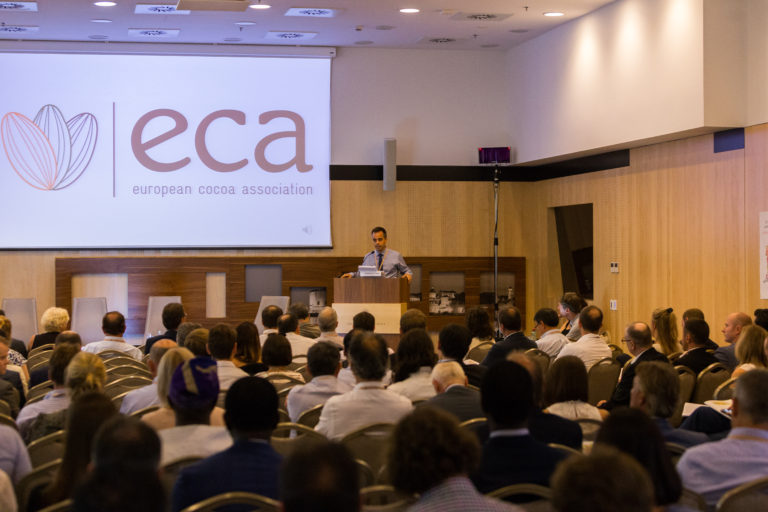What next for cocoa?

The European Cocoa Association (ECA) held its sixth European Cocoa Forum on 15-16 September in Dubrovnik, Croatia. This year’s edition, which welcomed 230 participants from both the private and public sectors, covered a variety of topics, including a focus on Central and Eastern Europe, climate change, cocoa research, regulatory concerns and innovation.
The ECA is a trade association that groups the major companies involved in the cocoa bean trade and processing, in warehousing and logistical related activities in Europe. On behalf of its members, ECA monitors and reports on developments impacting the cocoa sector, both at regulatory and scientific levels.
Consumption challenges
At the top of the agenda for discussion was the reported interest of market opportunities within Central and Eastern Europe. Despite the new found focus, chocolate consumption challenges in the area are affecting its potential future growth.
Gerry Manley, CEO of Olam Cocoa and ECA board member, explained how chocolate confectionery market growth has slowed following the financial crisis of 2009 and experienced further negative growth since 2014. “Between 2002 and 2008, we saw a six per cent growth in the chocolate confectionery market within eastern Europe, but after the financial crisis it declined to two per cent. It is clear that from 2014 there has been a slowdown in the economy,” he noted.
Research firm Euromonitor International estimates that over the last five years, the region’s chocolate confectionery market has declined 1.1 per cent annually, as consumption suffered in the key markets of Russia, Ukraine and Switzerland.
However, according to Manley, cocoa powder consumption has seen a 3.5 per cent increase in the past year, led by Ukraine, Romania, Czech Republic and Croatia. With this in mind, Croatian confectionery manufacturer Kraš Food Industry believes its research and development work allows it to compete within this volatile market.
“Technology for chocolate is changing and improving – we have shorter production times and lower energy costs,” said Marija Carić, chief engineer for product development at Kraš. “The best thing for our product is to be stable with our brands and have control of our raw materials and production processes.”
Damir Bulić, chairman at Kraš, believes the strongest competition comes from international brands. In an attempt to tackle this, Kraš has three manufacturing facilities in Croatia with space to expand the number of production lines it operates, allowing the group to produce 50 new or improved products annually.
Carić explained, “The production of chocolate flavour-based products and sugar confectionery at a single location in Zagreb enables the development of various cross-segment products.”
Adaptation is key
Climate change is one of the biggest challenges facing the cocoa sector, but many industry experts seem to be unclear on its actual definition. Scientist Christian Bunn, from the International Centre for Tropical Agriculture, stressed the importance of understanding that climate change is not just bad weather.
“Climate change means that businesses are no longer sourcing and producing on the best locations or using optimal technologies, instead they have had to adapt to a new, normal climate,” he explained.
According to Bunn, in order to move forward, the cocoa sector needs to become better adapted to climate change. This can begin through gaining a better understanding of what climate change means to the production systems of cocoa.
“Every supply chain has hotspots that need to be identified and solutions need to be developed that are cost effective,” he added.
However, for adaptation to take place investment is required. Brigette Laliberté, expert of cacao genetic resources at international research institute Bioversity International, said, “Climate change is an opportunity to track funding in a very neglected area of work. Farmers are still growing low yielding varieties which are susceptible to drought, pests and diseases.”
The research organisation has reported a 40 per cent loss of annual global production due to pests and diseases. “The reason cocoa production is relying on such small varieties falls to climate change and the reduced capacity to adapt to the ever- changing environment,” she added.
“Investment in research will enable diversity to be put to use so that smallholder producers can profit from the growing demand for chocolate, and the global cocoa industry will be able to meet the rising demand for chocolate.
“If this is the crop we are going to continue working on we must accept its limitations and invest in making it adaptable for the future.”
A call for research
There is a collective agreement for a more coordinated effort needed between research institutes to respond to producing countries and industry needs.
According to Wongbé Yté, general director at the National Agronomic Research Centre of Côte d’Ivoire, the challenge is not only thinking about new cocoa farms but the next generation of cocoa farmers, and attracting people to work on cocoa farms nowadays is a challenge in itself.
“As scientists we want to see a flourishing future for today’s cocoa growing regions, including Ghana, Brazil, Cote d’Ivoire and Ecuador,” Yté said. “This will only happen if there is a modernisation of cocoa. We don’t believe there is one unique solution, but it is about time we shared our focus on transforming cocoa cultivation and modernising it to attract young people.”
Alongside this, another concern facing the research community is how to put this research to good use. There has been a reported failure to reach enough farmers and a failure to get farmers to adopt the best practices.
“We are from a theory where we have to keep what we are doing to ourselves, but we have to get it out there so we can start coming up with some solutions,” said Jayne Crozier, trade and commodities coordinator at the Centre for Agriculture and Biosciences International (CABI).
“We have got to find out how we can adapt data so that farmers can use our research as they aren’t doing anything with it at the moment.”
Philippe Petithuguenin, director general of research and strategy at the French Agricultural Research Centre for International Development (CIRAD), believes a new breed of scientists are needed to take on the challenges faced by the research community today.
“When we retire can we convince our boards that it is time to create new scientists to work on cocoa?” he asked the audience.
There is a strong belief among the research community that within Europe they can contribute to benefit the cocoa sector globally by engaging in partnerships, industry trade and the scientific field.



